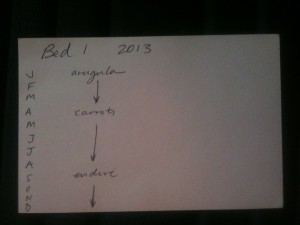March is here, the weather is getting milder, and for all early comers the garden is waiting and ready. Being out in the garden transplanting or seeding at this time of year can feel positively giddy and can lead to the peculiar excess of overplanting. Here’s how it works for me. Winter’s grip is relaxing, and the seed orders have all come in. When a sunny day hits, I just want to be out there as much as possible. I move from bed to bed, weeding, cultivating, fertilizing, then seeding. Deeply absorbed in my work I often don’t realize just how much of the garden I am planting up. Bare ground becomes something to just throw some seed at. Oh, I’ll plant some mizuna here; I’ll throw some radish seed there; Look, a tiny little bare spot – just right for some fennel transplants. Before long, the whole thing is planted. Now that may be a point of pride in some ways, to have a full garden before most other gardeners have even turned over a shovelful of earth, but it can come back to haunt you in a few months as well.
We all know radishes are pretty speedy little veggies, but lettuce, peas, carrots and the rest of the springtime crew need time like anything else, especially when soils are still cold, and germination and growth rates slow. What happens when late May or June rolls around and you are ready to lay down some serious summer veggies?…but wait, there’s no space. Sure you can strategically remove some lettuce from a patch to make way for a tomato start here or there, but do you want to have to pull up your entire carrot crop at only pinkie finger size (when you know that in another month they’ll be fat and long) to put in those direct-seeded beans? Truly these are great anxieties, but one need not stay paralyzed by them. A good planting plan resolves all!
To me a planting plan involves two components: a schedule of when to plant what, and a map of the garden which links that schedule to what will be planted where. Scores of websites, books, and pamphlets can tell you what to plant at what time of the year. Your own experience should weigh in heavily as well. For example, kale grows very well in the spring, and I like kale, so I could plant a lot of it, but my experience indicates that it gets preyed upon by aphids come warm weather and starts to limp along, whereas if I plant it in the fall, it has no problems, tastes better in the winter because of the starch-to-sugar-antifreeze effect, and I get a flush of it the following spring which often proves better than early plantings. So I’ve pretty much eliminated spring-planted kale from my schedule.
Translating the plan to a map or model of the garden is a little trickier. Computer spreadsheets can work well for this, but I have always preferred something more physical, so I usually use index cards, one card per bed or area. If you represent the year with the first letters of the month, JFMAMJJASOND, down the card, then you can have a view of what’s going on in the bed throughout the year. Some skill lies in estimating when a crop will be ready for harvest, but after a few seasons and copious note-taking, one can develop the knack.
So if you plan your garden in the winter, then have the discipline to actually work the plan, you will get a garden full of the things you really enjoy eating in the seasons you really enjoy eating them, not a garden dictated by the whims of the moment. It may take staring at a few bare beds in the spring, but often restraint is the better part of valor, no?


